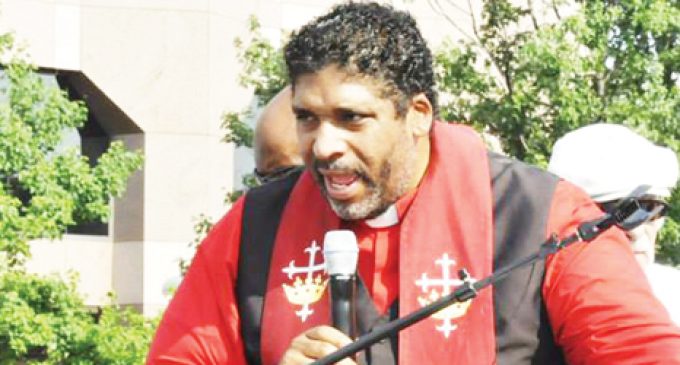Commentary: Veto the ‘Historical Artifact and Patriotism Act,’ Governor McCrory

In above photo: Rev. Dr. William J. Barber
William J. Barber, Guest Columnist
This afternoon [Tuesday, July 21], the North Carolina House of Representatives voted to pass the “Historical Artifact and Patriotism Act,” which makes it virtually impossible for local communities to move Confederate monuments.
The measure, which came out of the House Homeland Security Committee, was fast-tracked to Gov. McCrory’s desk to be signed.
The NC NAACP and Forward Together Moral Movement call on Gov. McCrory to veto this bill. The Rev. Dr. William J. Barber II has issued the following statement on their behalf: Rushing to protect monuments of the Confederacy rather than readily protecting the citizens of our state is extreme and wrongheaded.
The urgency with which the majority of our state representatives raced to protect Confederate monuments is appalling and shameful, given that hundreds of thousands of North Carolinians live without health insurance due to the General Assembly and Governor’s refusal to expand Medicaid; given that thousands of North Carolinians need a living wage, that teachers need job security, that public schools need adequate funding, that our environment needs adequate protections.
The extreme leadership of our General Assembly fast-tracked a bill to protect symbols of the past that embody division and secession from the Union while they remain at an immoral standstill on the critical issues of our day that would help the poor and working poor as well as address the continuing reality of racial disparities and inequality.
In these perilous days, it would seem that the Homeland Security Committee might be protecting our lives instead of the Lost Cause.
While it cannot rank with public safety or public schools as a priority, communities should be able to discuss moving Confederate monuments off prominent public places like courthouse lawns.
These conversations would do more to advance historical understanding than any number of monuments to the Confederacy.
Museums, which are able to explain and contextualize exhibits, might well be the best place for Confederate statuary.
Government-run shrines to an army that sought to overthrow the United States of America by force do not make sense.
Nor can they ever represent the North Carolinians whose ancestors suffered under the system of slavery that the Confederacy left America to defend.
If we are putting up Civil War-era monuments, it would be well to include a monument to the enslaved Africans who built the South and helped bring down the Confederacy – almost 200,000 African-Americans, many of whom escaped from slavery, fought for the Union.
We could consider a monument to Abraham Galloway, for example, who escaped from slavery, served as a Southern spy for the Union, and after the war helped to write the North Carolina Constitution that we still use.
We might also consider a monument to the roughly ten thousand Heroes of America, better known as the “Red Strings,” a secret society of white anti-Confederate guerillas across the state. Hundreds of thousands of ordinary white North Carolinians believed that the Civil War was “a rich man’s war and a poor man’s fight,” objected to the tyranny of the Confederacy, which they have never voted to support, and resented Confederate conscription laws that exempted wealthy white men and their sons.
As the war raged on, Gov. Zebulon Vance – who has a monument on the Capitol lawn – acknowledged that “the great popular heart is not now and never has been in this war. It was a revolution of the politicians and not the people.”
Likewise, there ought to be a monument to the Fusion Coalition of the 1890s, an interracial political force that swept every statewide election, captured the legislature, won both U.S. Senate seats, and elected a governor, too.
This Fusion alliance between mostly black Republicans and mostly white Populists was imperfect, to be sure, but was also an important experiment in interracial democracy.
They could not be beaten at the polls, and their extreme opponents turned to violence, intimation and fraud.
The leaders who overthrew the state government in the 1898 “white supremacy campaign” are represented by statues on the Capitol grounds; their Fusionist adversaries, who are a much better example for us today, are largely forgotten.
Public memorials are important. Rep. Marilyn Avila, a Raleigh Republican, states of this pro-Confederate bill: “When you talk about memorials and remembrances, the point of time at which they were erected is extremely relevant. A lot of these things were done shortly after the War Between the States.”
In fact, virtually none of the Confederate monuments were constructed until nearly fifty years after the war.
If the state had tried to build Confederate monuments shortly after the Civil War – “War Between the States” is the pro-Confederate term – there likely would have been civil conflict.
The real heroes of North Carolina are the public school teachers for whom this legislature has shown contempt or indifference.
The real heroes are those who keep struggling without living wages or health care.
The General Assembly would do well to protect them before they start protecting their own “right” to tell communities what to do with their public monuments.
Rev. Dr. William J. Barber II President, N.C. NAACP Working in Raleigh.











